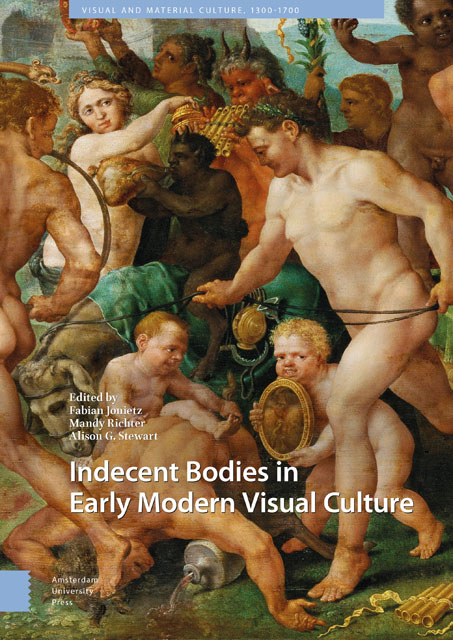Book contents
- Frontmatter
- Table of Contents
- List of Illustrations
- Indecent Bodies in Early Modern Visual Culture: An Introduction
- 1 Taste, Lust, and the Male Body: Sexual Representations in Early Sixteenth-Century Northern Europe
- 2 Private Viewings: The Frankfurt Context of Sebald Beham’s Die Nacht
- 3 To Show or Not to Show? Marcantonio Raimondi and the Representation of Female Pubic Hair
- 4 Treating Bodily Impurities: Skin, Art, and Medicine
- 5 Indecent Exposure and Honourable Uncovering in Renaissance Portraits of Women
- 6 Lust in Translation: Agency, Sexuality, and Gender Configuration in Pauwels Franck’s Allegories of Love
- 7 ‘So this guy walks into a forest…:’ obscenity, humour, sex, and the equine body in hans baldung’s Horses in a forest woodcuts (1534)
- 8 Indecent Creativity and the Tropes of Human Excreta
- 9 ‘It All Turns to Shit’ – The Land of Cockaigne in Sixteenth-Century German Woodcuts
- 10 Noëls and Bodily Fluids: The Business of Low-Country Ceremonial Fountains
- Index
Indecent Bodies in Early Modern Visual Culture: An Introduction
Published online by Cambridge University Press: 19 April 2023
- Frontmatter
- Table of Contents
- List of Illustrations
- Indecent Bodies in Early Modern Visual Culture: An Introduction
- 1 Taste, Lust, and the Male Body: Sexual Representations in Early Sixteenth-Century Northern Europe
- 2 Private Viewings: The Frankfurt Context of Sebald Beham’s Die Nacht
- 3 To Show or Not to Show? Marcantonio Raimondi and the Representation of Female Pubic Hair
- 4 Treating Bodily Impurities: Skin, Art, and Medicine
- 5 Indecent Exposure and Honourable Uncovering in Renaissance Portraits of Women
- 6 Lust in Translation: Agency, Sexuality, and Gender Configuration in Pauwels Franck’s Allegories of Love
- 7 ‘So this guy walks into a forest…:’ obscenity, humour, sex, and the equine body in hans baldung’s Horses in a forest woodcuts (1534)
- 8 Indecent Creativity and the Tropes of Human Excreta
- 9 ‘It All Turns to Shit’ – The Land of Cockaigne in Sixteenth-Century German Woodcuts
- 10 Noëls and Bodily Fluids: The Business of Low-Country Ceremonial Fountains
- Index
Summary
Indecency ‒ the polar opposite of propriety, appropriateness,respectability, decorum ‒ has played a central role in ourunderstanding of Early Modern cultural norms since the beginning of arthistory as an academic field in the nineteenth century. Accordingly, theconcept of indecency was fundamental to historical and contemporarydiscourses that attempted to balance social limits on indecorous behaviourand images. At the same time, the appeal of such visual imagery, theattraction of graphic depictions of bodies and their actions, resulted inconflicting responses on the part of viewers.
Historically, decency and indecency played defining roles in both the idea ofthe ‘Renaissance’ and its characteristics. Thenineteenth-century view of this period ‒ notably shaped by JacobBurckhardt and his Civilization of the Renaissance in Italy(1860) ‒ not surprisingly saw the Renaissance as the birthplace ofmodern individualism, and with it ideas of the idealised, the classical,‘clean’ beauty, and striving for grace. Since the 1950s, theidea of the European Renaissance north and south of the Alps has expanded toinclude the struggle between decorous and indecorous elements, a factacknowledged within art history, cultural studies, and philology followingEugenio Battisti's L’Antirinascimento(‘The Anti-Renaissance’, 1964), the ground-breaking work ofMikhail Bakhtin's Rabelais and His World (1965,English translation 1984), and the general reassessment of sixteenth-centuryMannerism.
The alleged individualism of Renaissance men and women led Stephen Greenblatt(Renaissance Self-Fashioning, 1980) and the large fieldof studies addressing selffashioning to acknowledge that being sociallyimproper or indecent had become, in fact, equally important to individualismfor Early Modern society and courts. One example is Benvenuto Cellini assomeone continuously opposing the model of the courtier propagated byBaldassare Castiglione (The Book of the Courtier, 1528) orGiovanni della Casa (Galateo: The Rules of Polite Behavior,1558), the ideal neither to offend nor to stand out. Yet, it is worthremembering that well before what might be called the rediscovery of the‘Indecent Renaissance’ and well before Burkhardt, JohannWolfgang von Goethe centred his sixteenth-century play TorquatoTasso, written in the 1780s, around the clash of these twoconcepts: Is everything allowed that pleases (erlaubt ist wasgefällt), as he lets the Italian poet Tasso argueimpetuously in a nostalgic vision of the Golden Age?
- Type
- Chapter
- Information
- Indecent Bodies in Early Modern Visual Culture , pp. 15 - 38Publisher: Amsterdam University PressPrint publication year: 2022



